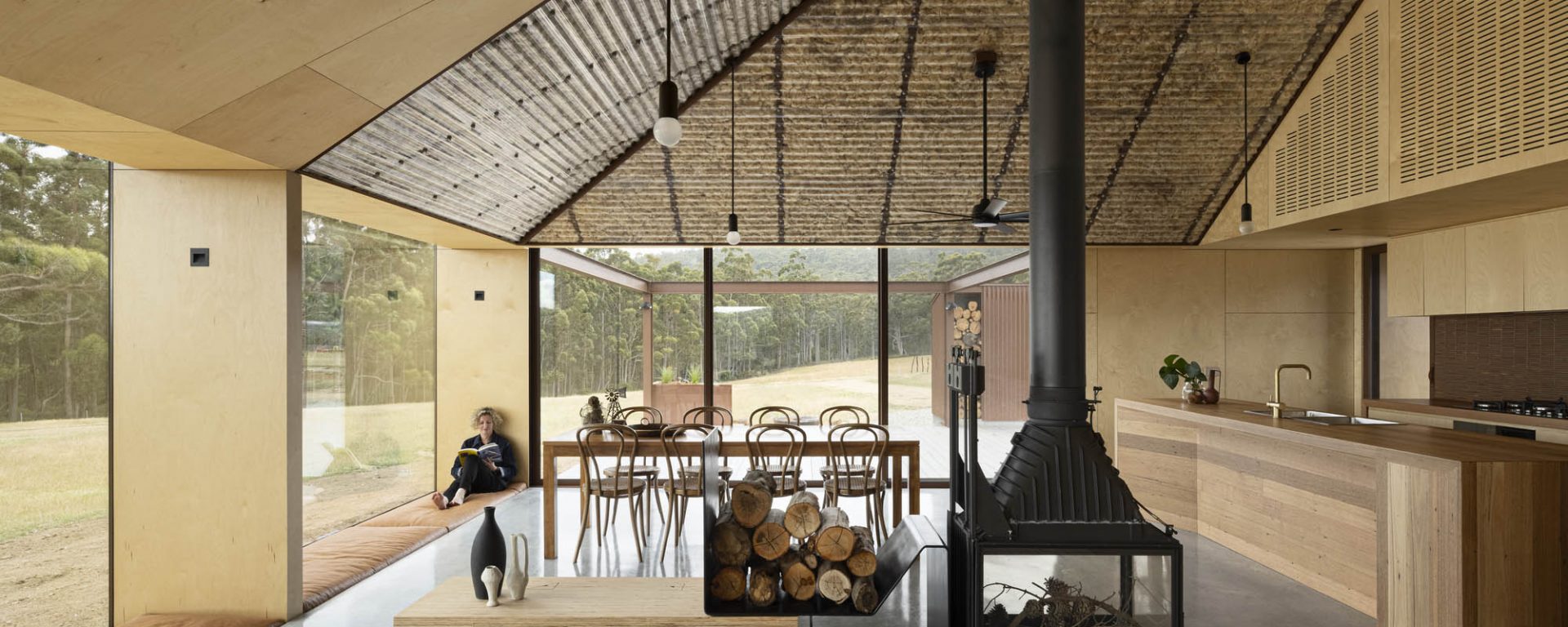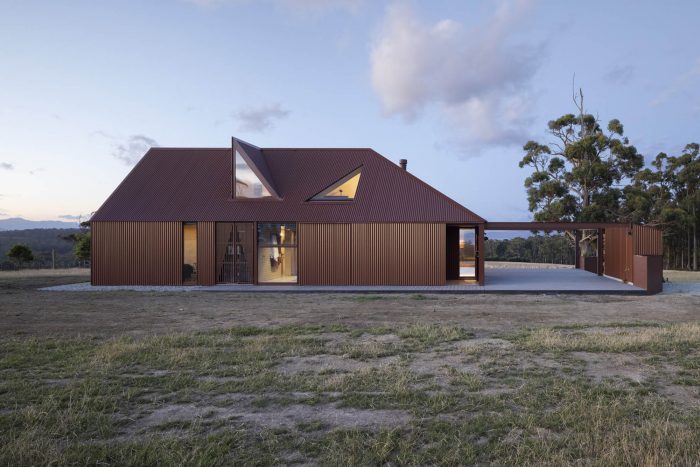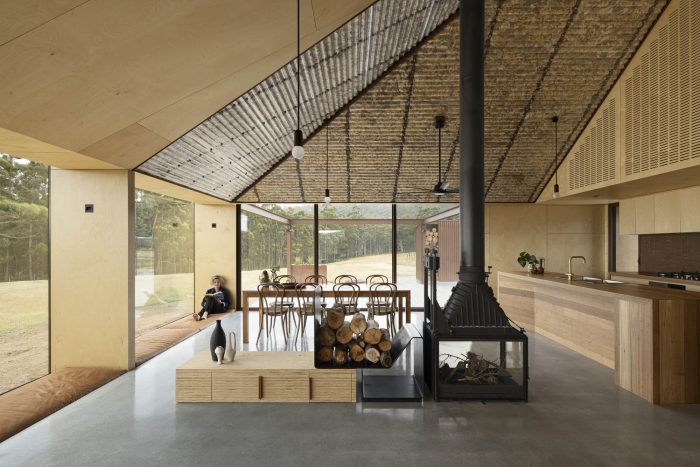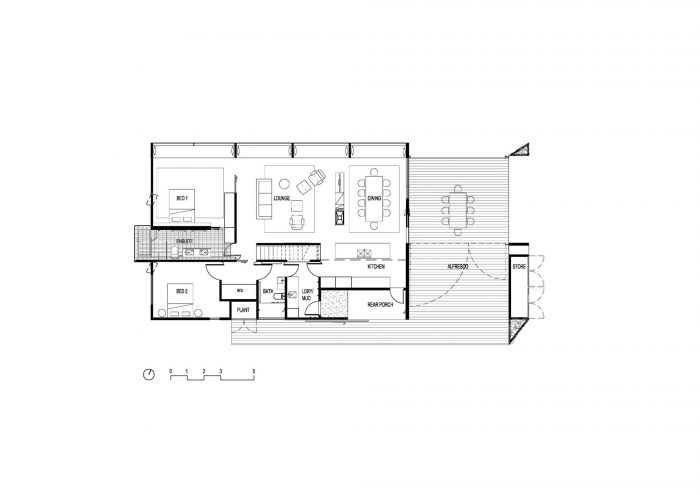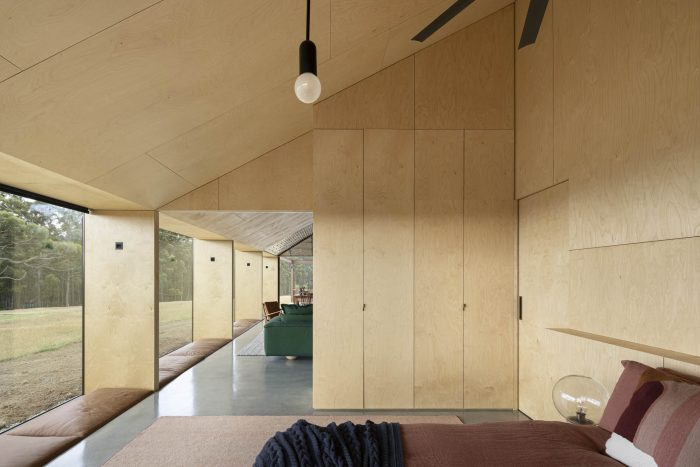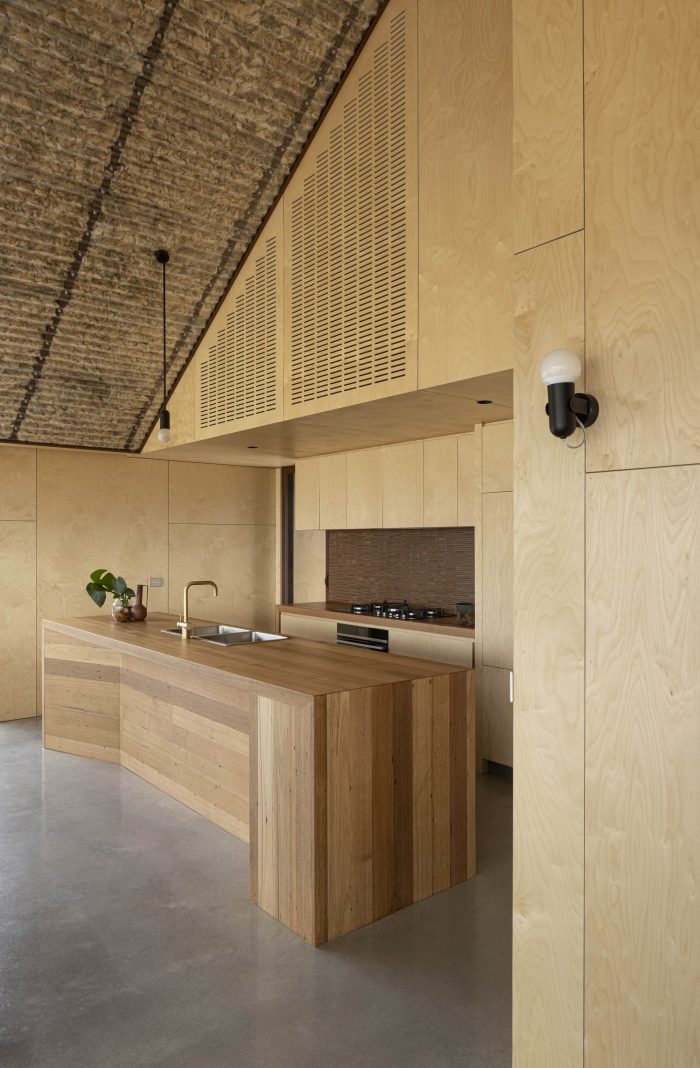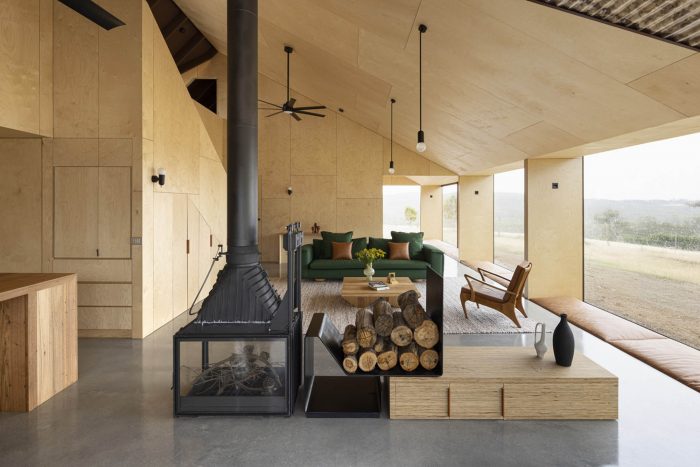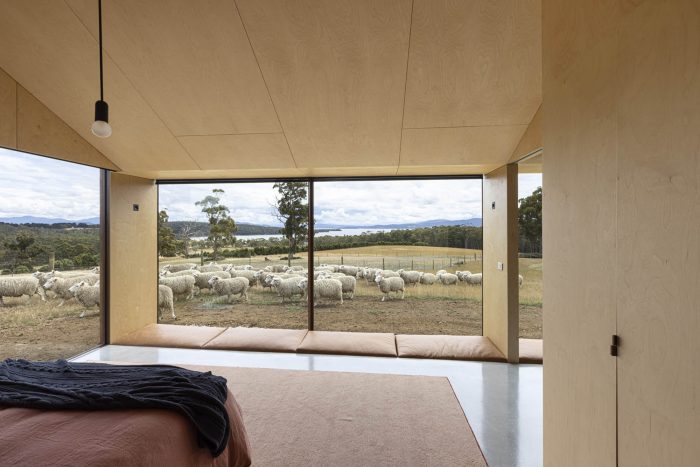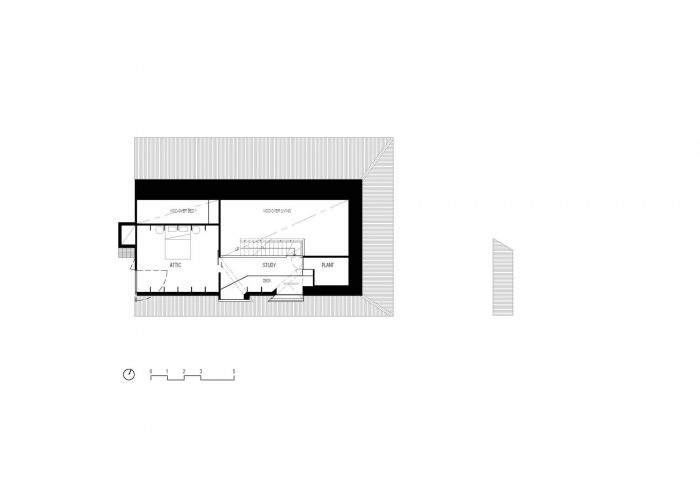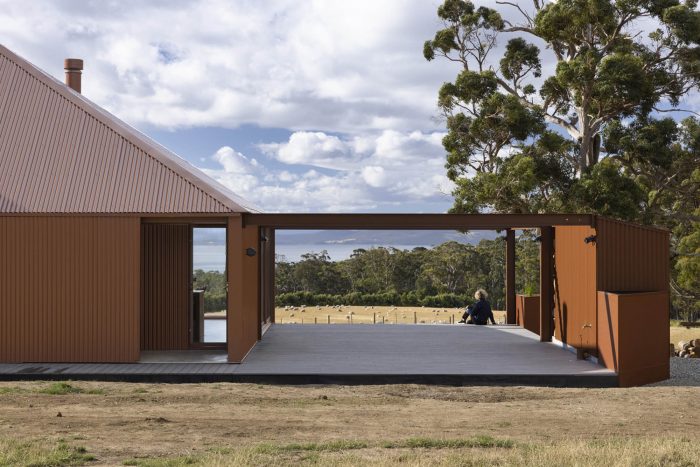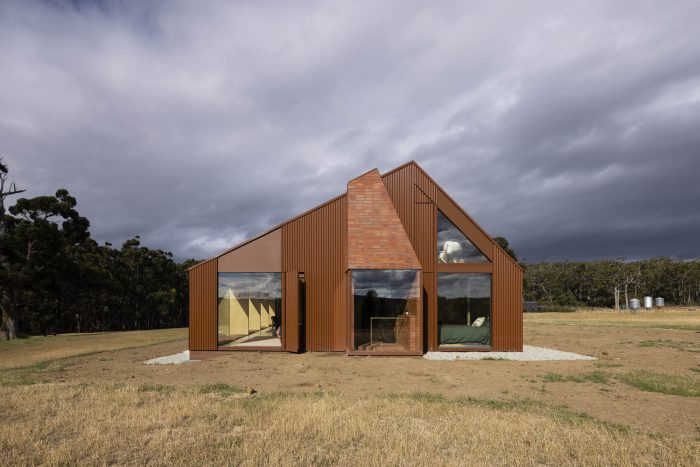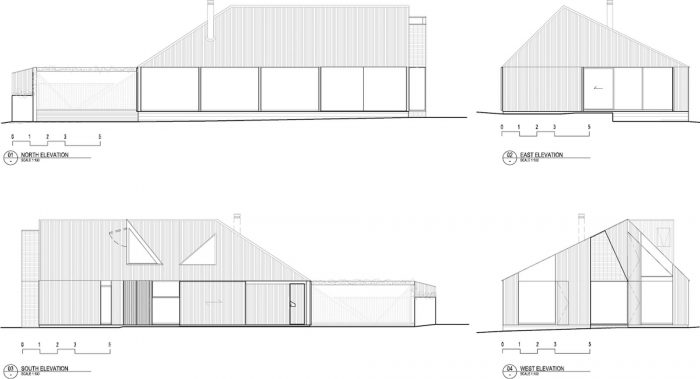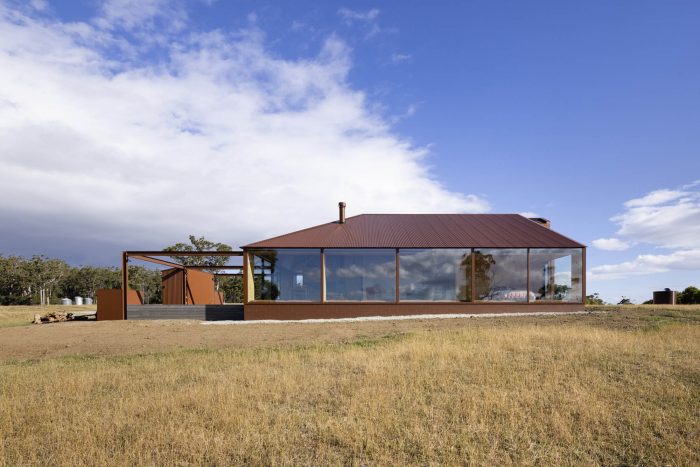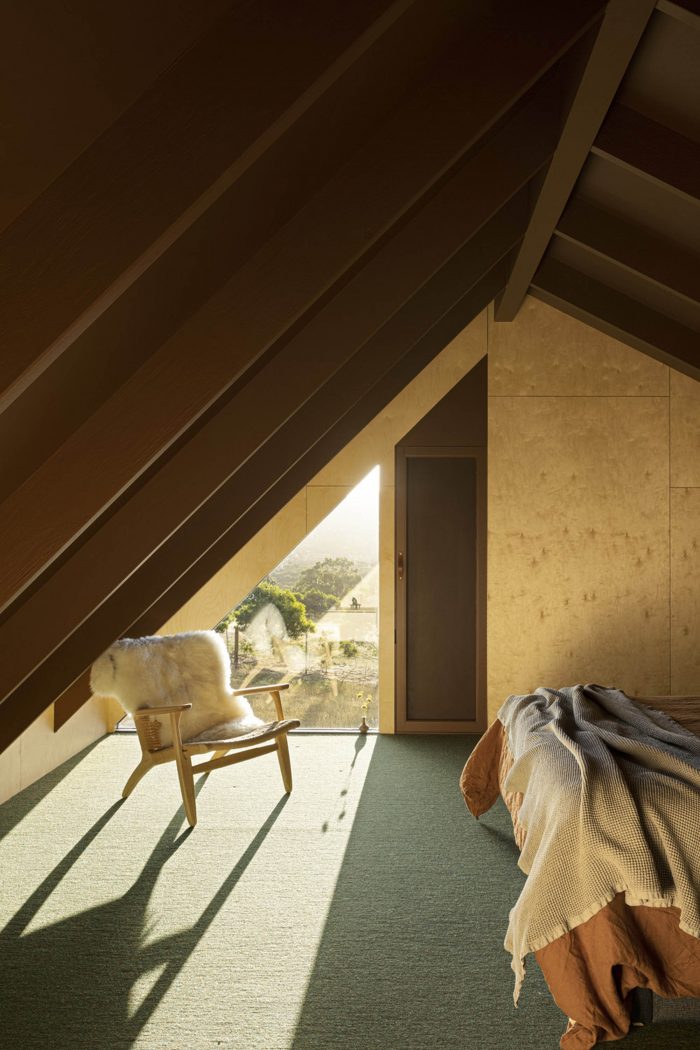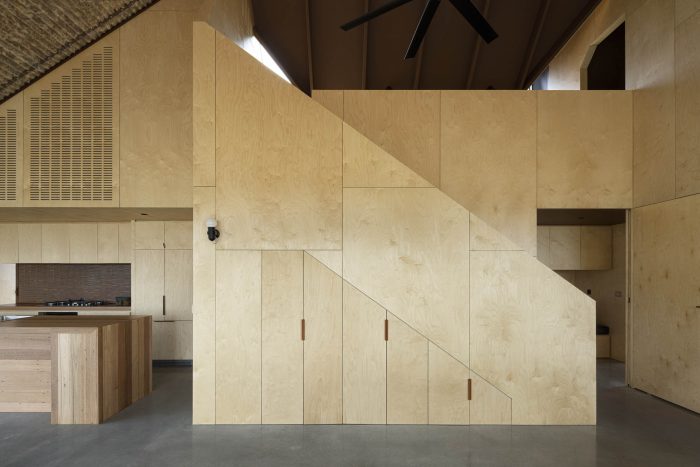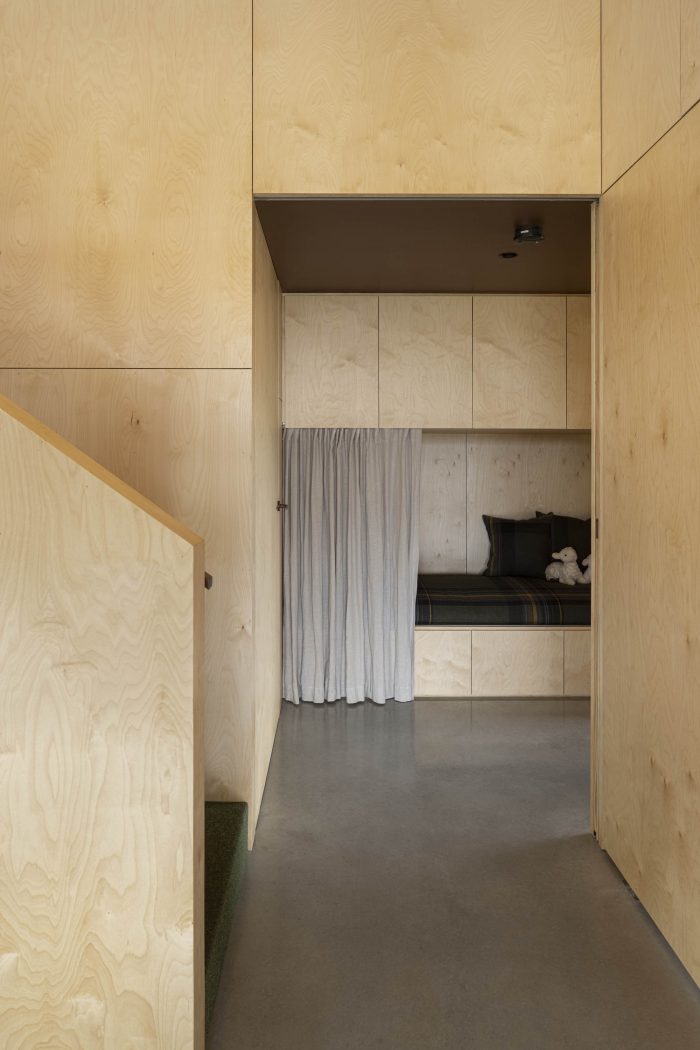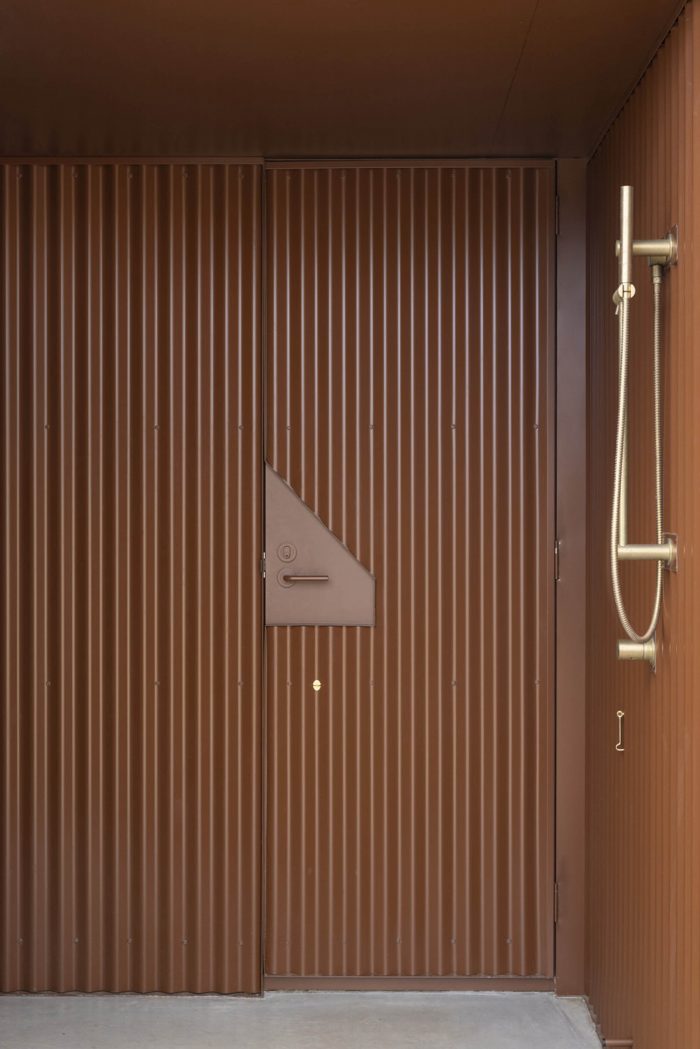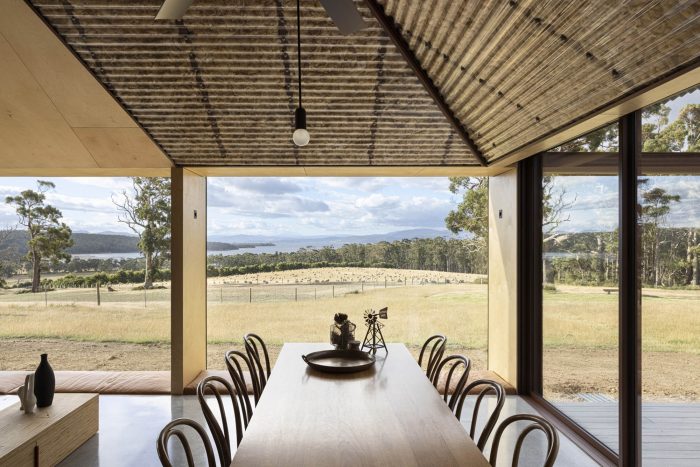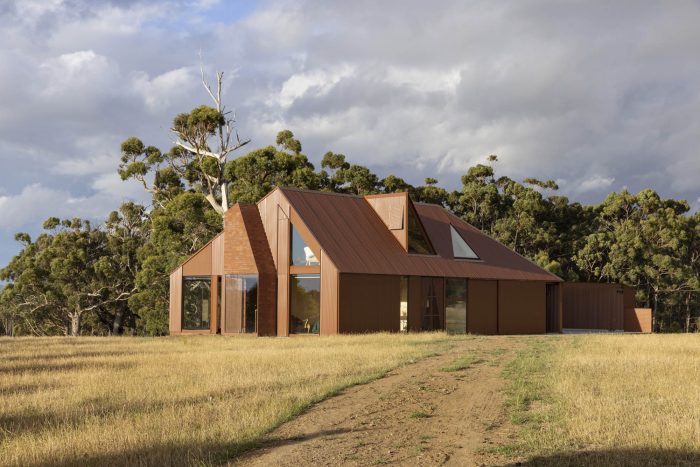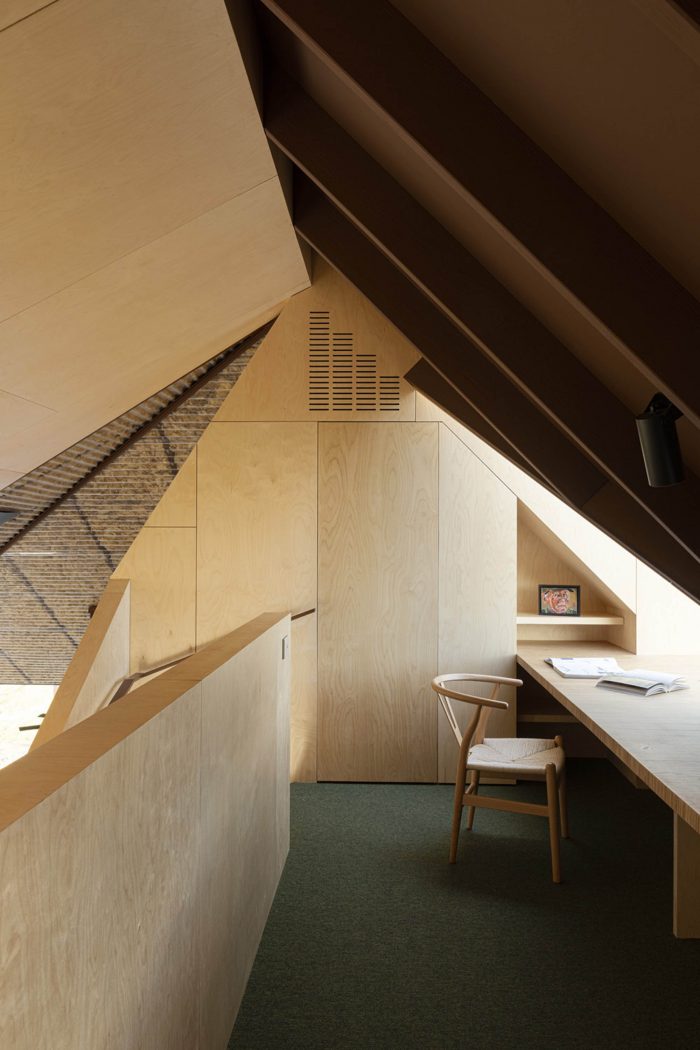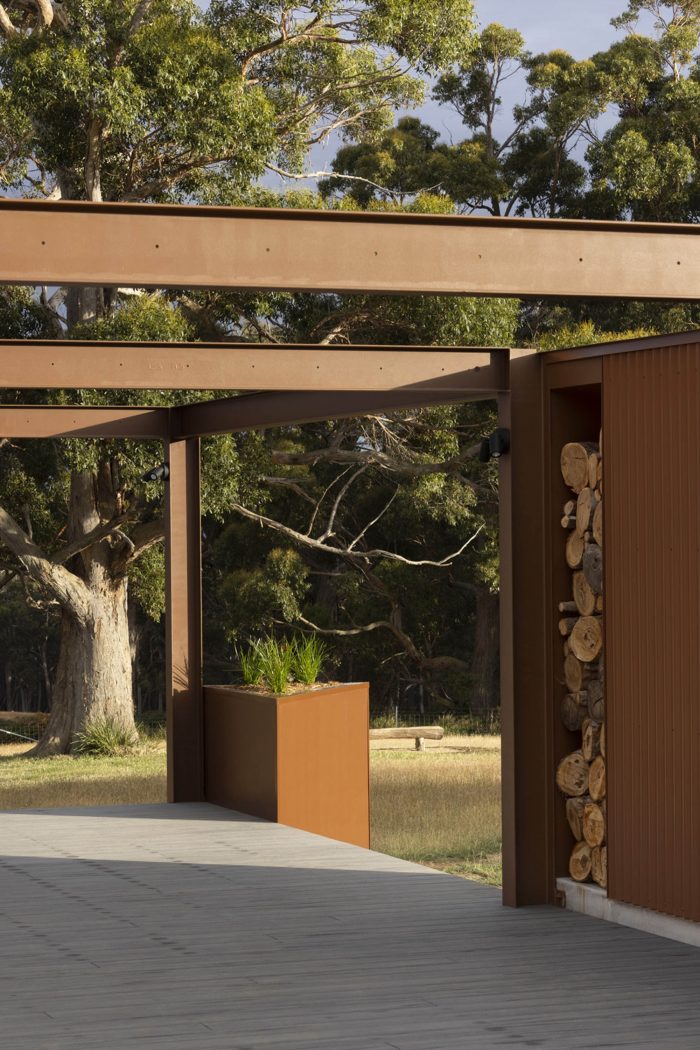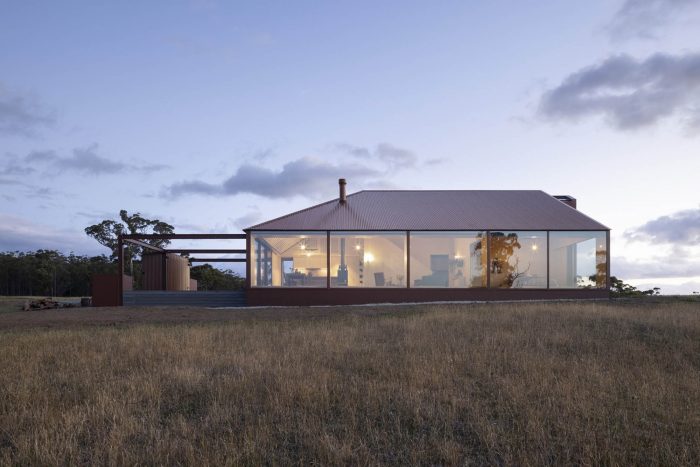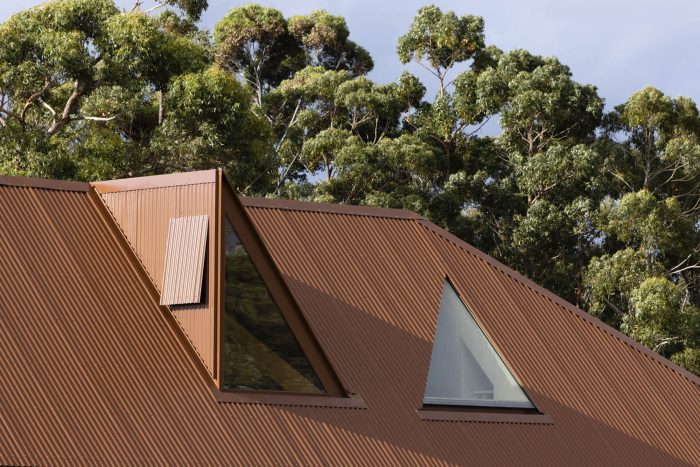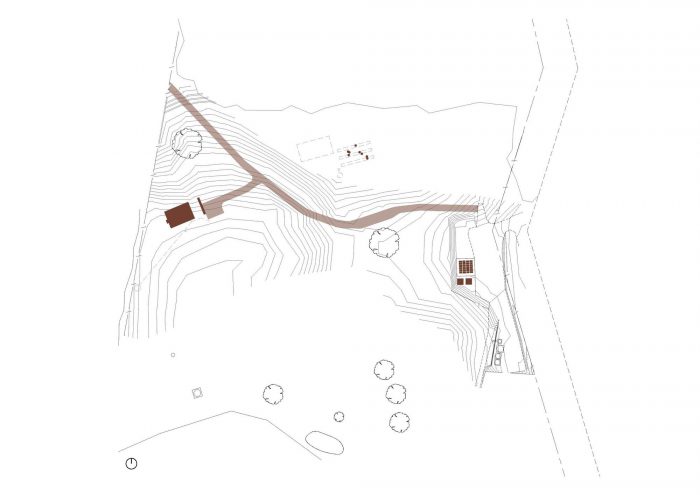库普沃斯坐落在塔斯马尼亚州布鲁尼岛的乡村环境中,是对乡村农舍的现代诠释。岛上居住的库普沃斯羊、广阔的水面和山脉视野,以及遍布全岛的风化的红色铅制小屋,为房子提供了一个不断变化的景观,与之对话。
Nestled in the rural surrounds of Bruny Island, Tasmania, Coopworth is a contemporary interpretation of a country farmhouse. The site’s resident Coopworth sheep, the wide-ranging views to the water and mountain ranges beyond, as well as the weathering red lead shacks dotted over the island provide an ever-changing landscape with which the house converses.
房子的占地面积被有意识地限制,以最大限度地增加可耕地,但在其深思熟虑的内部安排中保持了宽广的空间。在内部,高大的体量和舒适的空间的对比通过夹板衬里和混凝土地板的功利性调色板得到了强调,并将焦点吸引到一个戏剧性的天花板上,天花板上衬有来自该地产的Coopworth羊毛。用透明的聚碳酸酯波纹板密封,羊毛增加了热性能,同时作为抽象的羊毛壁画来庆祝农业的联系。
The footprint of the house is consciously constrained to maximize arable land yet maintains generosity in its thoughtful internal arrangement. Internally, the contrast of lofty volumes and snug spaces are accentuated by a utilitarian palette of plywood linings and concrete floors, drawing focus to a dramatic ceiling lined with Coopworth wool from the property. Sealed with clear, polycarbonate corrugated sheeting, the wool adds to the thermal performance, while celebrating the agricultural connections as an abstract wool fresco.
北部立面建立了一个有节奏的窗龛,以捕捉风景。无框窗户被推到楼板的边缘,以迎接狂风和暴雨–既沉浸在美丽和残酷的天气中,又受到良好的保护。
The northern elevation establishes a rhythm of window niches, capturing the view. Frameless windows are pushed to the edge of the floorplate to embrace wild winds and rains – at once immersed in the beauty and brutality of the weather and well protected from it.
在西面的立面,历史悠久的棚屋上无处不在的烟囱被重新想象成一个下沉式浴池,从而将沐浴者与周围的围场和居住的羊群以及远处的海湾连接起来。
On the western elevation, the ubiquitous chimney stack seen on the historic shacks is reimagined as a sunken bath, thus connecting the bather to the surrounding paddock and resident sheep, as well as long views to the bay beyond.
虽然房子的设计是为了容纳两个主要的居住者,但通过对澳大利亚阳台卧铺和大篷车双层床的创造性解释,房子可以被打开来接待家人和朋友。窗台边上有下沉式床铺;这种类似野营的安排培养了家庭联系。一个像阁楼一样的夹层作为学习空间和客人的卧室,而另外一张胶合板床则谨慎地整合在一堵细木工墙中。定制的细节,包括一个折叠的钢制木柴架和皮革包裹的浴室设备,进一步增加了室内的纹理。
While designed to accommodate two principal occupants, the house can be opened up to host family and friends through creative interpretations of Australian verandah sleepouts and caravan bunk beds. Window bays are bordered with sunken beds; a camping-like arrangement nurturing familial connections. An attic-like mezzanine serves as study space and guest bedroom, while an additional plywood-lined bed is discreetly integrated amongst a wall of joinery. Bespoke details, including a folded steel firewood stand and leather-wrapped bathroom fittings, add further interior grain.
这座房子解决了可及性、寿命和可持续性问题。地面沟渠消除了屋顶水槽,而除了一个屋顶穿透物外,所有的穿透物都被移除,减少了泄漏和火灾风险。紧凑的空间,在不使用时可以关闭,大大减少了加热和冷却的需求。紫外线热量和辐射在夏季高峰期被日间床的 “内檐 “吸收,而混凝土地板、羊毛衬里天花板、可操作的通风板和吊扇有效地调节了温度。
The house addresses accessibility, longevity and sustainability. In-ground trenches eliminate roof gutters, while all but one roof penetration is removed, mitigating leaks and fire risks. Compact spaces that can be closed off when not in use significantly reduce heating and cooling demands. UV heat and radiation is absorbed by the ‘internal eave’ of day beds in peak summer, while concrete floors, wool-lined ceilings, operable ventilation panels and ceiling fans effectively moderate temperatures.
附近农场大棚上的大型太阳能电池阵和水箱提供了自给自足的水和电力供应,而高效、缓慢燃烧的木火是主要的供暖来源。空间的设计是通用的,考虑到了残疾家庭和这对夫妇未来的潜在需求。
A large solar array and water tanks on the nearby farm sheds provide a self-sustaining water and power supply, while an efficient, slow-combustion wood fire is the main source of heating. Spaces are designed for universal access, with consideration of family with disabilities and the couple’s potential future needs.
房子的轻质结构便于将建筑材料运到偏远的地方,同时呼吁当地行业减少旅行并与社区建立联系。自然和本地产品受到青睐,包括胶合板和回收的木材。家具和LED照明是当地设计和制造的。由当地第一民族艺术家Robby Wirramanda创作的烧焦的木材雕塑,为保护化粪池不受农场机械的影响提供了一个引人注目的特定场地,重申了景观中实用性和诗意之间的平衡。
The house’s lightweight construction eased transportation of building supplies to the remote site, while local trades were called upon to reduce travel and build ties with the community. Natural and locally sourced products were favoured, including plywood and recycled timber. Furniture and LED lighting is locally designed and made. Charred timber sculptures by local first nation artist, Robby Wirramanda, provides an arresting, site-specific addition protecting the septic field from farm machinery, reiterating the balance between the pragmatic and poetic within the landscape.
Architects: FMD Architects
Area: 263 m²
Year: 2020
Photographs: Dianna Snape
Manufacturers: Lysaught, Robertson Building Products, Timberwood Panels
Builder: IN2 Construction
Structural Engineering: Aldanmark Consulting Engineers
Design Team:Fiona Dunin, Jayme Collins, Alice Edwards, Robert Kolak, Fady Ghabbour, Oscar Eltringham-Smith
Architects:FMD architects
Country:Australia

